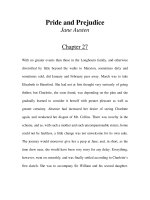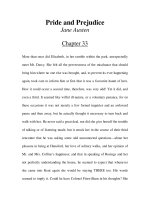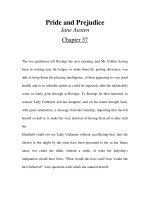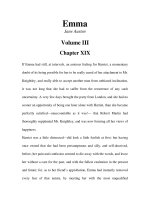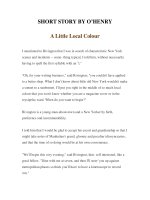Tài liệu Cách dùng tiếng Anh P4 docx
Bạn đang xem bản rút gọn của tài liệu. Xem và tải ngay bản đầy đủ của tài liệu tại đây (40.8 KB, 7 trang )
beside / besides
Some people argue that these two words should be kept distinct when they
are used as prepositions. By this thinking, you should use beside only to
mean “at the side of,” as in There was no one in the seat beside me. For
the meanings “in addition to” and “except for” you should use besides:
Besides replacing the back stairs, he fixed the broken bannister. No one
besides Smitty would say a thing like that. But this distinction is often
ignored by widely respected writers. While it’s true that besides can never
mean “at the side of,” you will often see beside used in place of besides in
print. Watch out for ambiguity when using beside in this way. The sentence
There was no one beside me at the table could mean that you had the
table to yourself or that the seats next to you were not occupied
better and best
Which do you think is best? The chocolate chip or the mocha supreme?
between and among
Between is used for two, and among for more than two.” This decree of
grammar may still echo in your old classroom, but you would be wise to
consider other reverberations as well. It is true that between is the only
choice when exactly two entities are specified. For example, you must say
the choice between (not among) good and evil and the rivalry between (not
among) Great Britain and France. But when more than two entities are
involved or when the number of entities is unspecified, the word choice
depends on what you want to say. You use between when the entities are
considered as distinct individuals and among when they are considered as
a mass or collectivity. Thus in the sentence The balloon landed between
the houses, the houses are seen as points that define the boundaries of the
area where the balloon touched down. We assume, therefore, that the
balloon did not land on any of the individual houses. In The balloon landed
among the houses, the area of landing is considered to be the general
location of the houses, taken together. It leaves open the possibility that the
balloon came down on one of the houses. By the same token, we may
speak of a series of wars between the Greek cities, which suggests that
each city was an independent participant in the hostilities, or of a series of
wars among the Greek cities, which allows for the possibility that the
participants were shifting alliances of cities. For this reason, among is used
to indicate inclusion in a group: She is among the best of our young
sculptors. There is a spy among you. Use between when the entities are
seen as determining the limits or endpoints of a range: They searched the
area between the river, the farmhouse, and the woods. The truck driver had
obviously been drinking between stops.
bimonthly / biweekly / semimonthly / semiweekly
If your therapy group has semimonthly meetings, how often should you
expect to show up? A bimonthly meeting should take place “once every two
months"; a biweekly, “once every two weeks.” A semimonthly meeting
should be held “twice a month” and a semiweekly “twice a week.” That’s
should. These words are often confused, and to spare nervous attendees
the suspense, the only decent thing to do is to use substitute expressions
like every two months or twice a month.
In the publishing world, where confusion is a rarity, a bimonthly always
comes out every two months, and a biweekly every two weeks
boast
Some have objected to the use of boast as a transitive verb meaning “to
possess or own a desirable feature,” as in This network boasts an audience
with a greater concentration of professionals and managers than any other
network
born / borne
These words are both past participles of bear. Here’s how to sort them out.
Use born only in passive constructions referring to birth: I was born in
Chicago. For all other uses, including active constructions referring to birth,
use borne: She has borne both her children at home. I have borne his
insolence with the patience of a saint
both
Both indicates that the action or state denoted by the verb applies
individually to each of two entities. Both books weigh more than five
pounds, for example, means that each book weighs more than five pounds
by itself, not that the two books weighed together come to more than five
pounds. Both is inappropriate where the verb does not apply to each of the
entities by itself.
bring and take
When do you use bring and when do you use take? It depends on your
point of view. We use bring to indicate motion toward the place of speaking
or the place from which the action is regarded. Thus you normally take
checks to the bank and bring home cash, although from the banker’s
perspective you have brought checks to the bank in order to take away
cash
When the point of reference is not the place of speaking itself, you can use
either verb depending on the context. Thus you can say either The labor
leaders brought their requests to the mayor’s office or The labor leaders
took their requests to the mayor’s office depending on whether you want to
describe things from the point of view of the labor leaders or the mayor.
Perhaps for this reason, the distinction between bring and take is
sometimes less clear than you might expect. A parent may say of a child,
for example, She always takes a pile of books home with her from school,
as the parent imagines the situation from the child’s viewpoint. This usage
may sound curious to those who are accustomed to observe the distinction
more strictly, but there is really nothing wrong with it.
capital / capitol
When touring the capital, why not visit the capitol? Capital and capitol are
terms that are often confused, mainly because they refer to things that are
in some ways related. The term for a town or city that serves as a seat of
government is spelled capital. The term for the building in which a
legislative assembly meets is spelled capitol
careen / career
That sportscar went careering down the road. Or did it careen? Careen
comes to us via Middle French from the Latin word carina, which meant
“the keel of a ship.” The original sense of the English verb was nautical and
referred to the way a ship would lean to one side when sailing in windy
conditions. Today, when used as a verb of motion, careen typically implies
high speed. It often but not always entails a sideways motion or wavering.
This sense probably came from the application of the nautical sense of the
word to automobiles, which usually only careen, that is, lurch or tip over,
when driven at high speeds
Career, on the other hand, has always been on dry land. It comes from
Middle French carriere, “race course,” which comes from Latin carrarria,
“carriageway,” and ultimately from Latin carrum, “cart, car.” (The
“occupation” sense is an extension of the “race course” meaning, although
many might find this metaphor a bit of a stretch today.) As a verb, career
originally meant “to move over a course.” In the verb’s first recorded usage,
the course was the lane for each horse at a jousting tournament. But the
kinds of courses and agents of motion soon proliferated, and the verb now
means “to move forward at high speed.”
center
Can you center on something and around it at the same time? Traditionally,
the verb center has been used with the prepositions on, upon, in, or at, but
some language critics have denounced its use with around as illogical or
physically impossible. Still, the fact that many writers persist in using this
phrase in sentences such as The discussion centered around the need for
curriculum revision suggests that many people perceive center around to
best represent the true nature of what they are trying to say. Center can
represent various relations involving having, finding, or turning about a
center, and the choice of a preposition to accompany center depends on
the meaning you want to convey. There is ample evidence for usages such
as Our hope centered in the young leader, His thoughts centered on the
long journey before him, and The trade is centered at Amsterdam. Center
around is equally well established, as in A storm of controversy centered
around the king. In this example, around seems to be the only appropriate
choice. If using the phrase center around does not sit well with you,
however, try revolve around instead.


